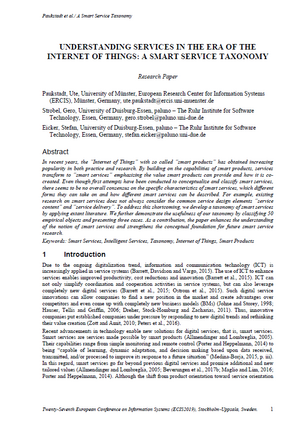Publikationen

Mit unseren Publikationen decken wir die unterschiedlichsten Forschungsbereiche ab, die sich im Feld von Mensch, Aufgabe und Technik ergeben. Neben traditionellen Themen der Wirtschaftsinformatik wie Wissensmanagement und Geschäftsprozessmanagement, finden Sie dabei auch Beiträge zu aktuellen Themen wie Blended Learning, Cloud Computing oder Smart Grids. Nutzen Sie diesen Überblick, um sich einen Eindruck über die Bandbreite und Möglichkeiten der Forschung der Wirtschaftsinformatik am Standort Essen zu verschaffen.

Art der Publikation: Beitrag in Sammelwerk
UNDERSTANDING SERVICES IN THE ERA OF THE INTERNET OF THINGS: A SMART SERVICE TAXONOMY
- Autor(en):
- Paukstadt, Ute; Strobel, Gero; Eicker, Stefan
- Herausgeber:
- Ais
- Titel des Sammelbands:
- Proceedings of the 27th European Conference on Information Systems (ECIS)
- Ort(e):
- Stockholm
- Veröffentlichung:
- 2019
- ISBN:
- 978-1-7336325-0-8
- Sprache:
- Englisch
- Schlagworte:
- Smart Services, Intelligent Services, Taxonomy, Internet of Things, Smart Products
- Link zum Volltext:
- https://aisel.aisnet.org/ecis2019_rp/72/
- Zitation:
- Download BibTeX
Kurzfassung
In recent years, the “Internet of Things” with so called “smart products” has obtained increasingpopularity in both practice and research. By building on the capabilities of smart products, servicestransform to “smart services” emphasizing the value smart products can provide and how it is co- created. Even though first attempts have been conducted to conceptualize and classify smart services, there seems to be no overall consensus on the specific characteristics of smart services, which different forms they can take on and how different smart services can be described. For example, existing research on smart services does not always consider the common service design elements “servicecontent” and “service delivery”. To address this shortcoming, we develop a taxonomy of smart services by applying extant literature. We further demonstrate the usefulness of our taxonomy by classifying 50 empirical objects and presenting three cases. As a contribution, the paper enhances the understanding of the notion of smart services and strengthens the conceptual foundation for future smart service research.
